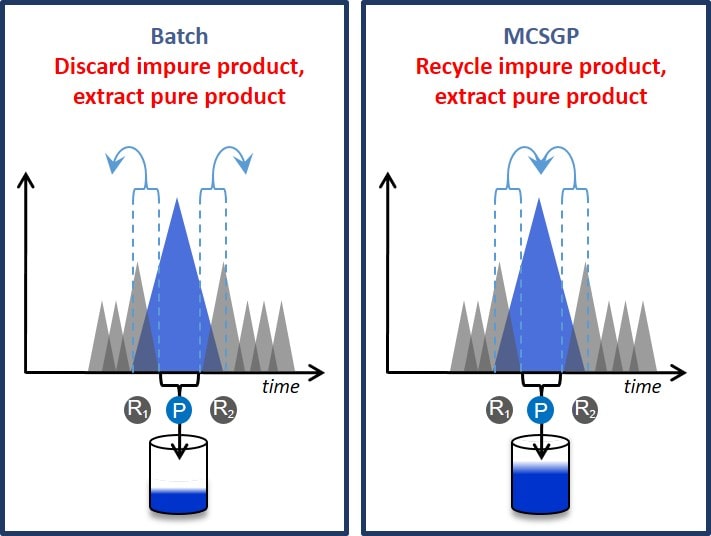MCSGP
A HIGHLY EFFECTIVE POLISHING PROCESS: MCSGP

Single column batch chromatography using gradient elution is often used to purify compounds in chromatography separations providing either high yield or high purity but never both. This trade-off between yield and purity can be overcome with MCSGP (Multi-column Counter-current Solvent Gradient Purification), a continuous process that delivers up to 80% more yield at target purity and operates with up to 10-fold higher productivity than batch. Contichrom CUBE Combined and HPLC system software allows to operate this process.
How does MCSGP work?

In batch chromatography, impure side fractions (R1 & R2 in the figure above) often have to be discarded to reach a certain product purity (P). With MCSGP, impure product-containing side fractions are internally recycled in a periodic closed loop process (see animation below on the left) while pure product is continuously extracted. Thereby, little product is lost and the yield of pure product is maximized without any accumulation of impurities and retaining target purity. This allows for a significant improvement in process economics. MCSGP gives higher yield and purity than batch chromatography (see Figure below on the right). In contract, reprocessing using a batch process will accumulate impurities and the reprocessing has to be stopped early in order to retain target purity specifications.
MCSGP is for example used for:
- Synthetic peptides
- Oligonucleotides
- Small molecules from fermentation or natural extractions (Stevia, Flavonoides, Cannabinoids, fish oil)
- Blood plasma products
- Recombinant proteins from microbial production
- Complex organic synthesis products
The MCSGP technology is patented by ChromaCon. The Contichrom CUBE Combined is capable of executing MCSGP processes. A dedicated software wizard in the accompanying ChromIQ software allows for easy batch-to-continuous process transfer and optimization.